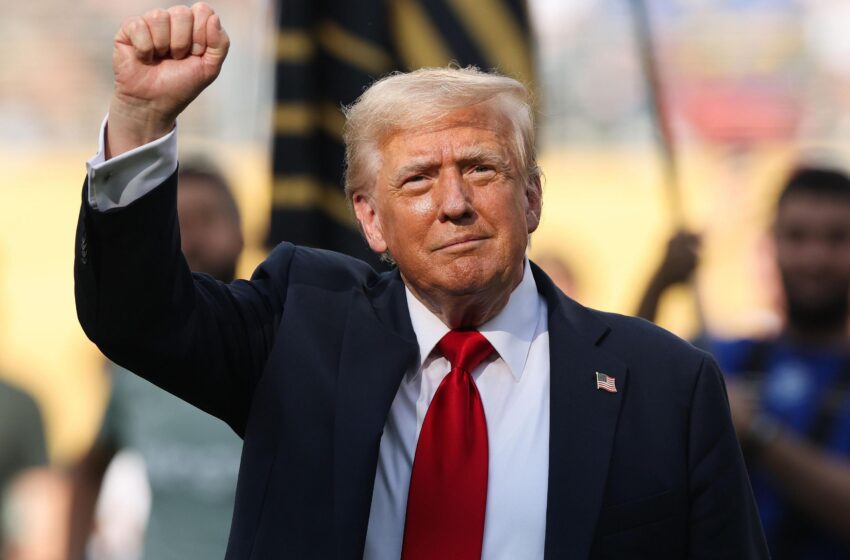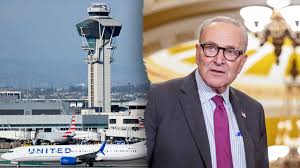What caused the 2025 federal government shutdown? How long will it last?

Donald Trump
With Congress stuck in stalemate, pressure is mounting on former President Donald Trump to personally intervene in negotiations to avert a government shutdown.
Both a Republican-backed temporary spending bill and a Democratic alternative failed in the Senate, leaving just nine days until federal funding runs out. Democrats argue that GOP leaders have refused to engage meaningfully in talks and are now urging Trump himself to step up to the bargaining table.
Democrats Appeal Directly to Trump
Senate Majority Leader Chuck Schumer, speaking on CNN’s State of the Union, called on Trump to meet with Democratic leaders to hammer out a deal. Schumer, along with House Minority Leader Hakeem Jeffries, also sent a formal letter to Trump requesting immediate talks to keep the government open past the September 30 deadline.
Trump appeared open to the idea, though he downplayed the likelihood of giving Democrats much ground. Over the weekend, he said Democrats had “learned nothing” from their 2024 election losses, while suggesting he would still “love to meet” with them.
Key Issue: Health Insurance Subsidies
At the heart of the dispute is the looming expiration of enhanced Obamacare premium subsidies, which help millions of middle-class Americans afford health coverage. Many Republicans quietly support extending the subsidies, fearing voter backlash if premiums spike. However, GOP leaders in Congress worry that discussing any deal linked to Obamacare could ignite opposition from the hard-right Freedom Caucus.
Some Democrats believe Trump may be more pragmatic on this point, capable of ordering Republicans to fall in line if he sees it as essential to his broader political goals.
The Politics of Shutdown Risk
The situation leaves both parties preparing for a high-stakes messaging battle. If talks collapse, Democrats intend to highlight what they see as Republicans’ complete dependence on Trump’s approval. Republicans, meanwhile, risk taking the blame if a shutdown leads to economic disruption or spikes in health care costs.
For Trump, the calculus is complicated. On one hand, he has shown renewed interest in punishing political opponents and energizing his base, particularly after the assassination of conservative activist Charlie Kirk, which MAGA supporters blame on “the left.” On the other, Trump is focused on preserving Republican control of the House in the 2026 midterms. Avoiding voter anger over rising health costs could become a deciding factor in whether he intervenes.
What Comes Next
Whether or not Trump joins formal negotiations, his influence is undeniable. Without his blessing, congressional Republicans are unlikely to move forward. For Democrats, pressing him directly underscores the reality that GOP leaders such as Speaker Mike Johnson and Senate Majority Leader John Thune cannot act independently.
As the deadline approaches, both parties are bracing for either a last-minute deal or a political showdown over who bears responsibility for a shutdown.
FAQ
Q1: Why are Democrats asking Donald Trump to negotiate the shutdown deal?
Democrats argue that Republican leaders refuse to engage in serious talks without Trump’s approval. By calling on Trump directly, they hope to break the deadlock and prevent a shutdown.
Q2: What issues are at the center of the government shutdown negotiations?
The main sticking point is whether to extend enhanced Obamacare premium subsidies, which are set to expire at the end of the year. Democrats strongly support the extension, while Republican leaders face internal resistance from the Freedom Caucus.
Q3: What is Donald Trump’s response to Democrats’ request?
Trump has signaled he is open to meeting but dismissed Democratic demands as unreasonable. He has hinted that Republicans should not make major concessions after their 2024 election victory.
Q4: How could the Obamacare subsidies impact the shutdown debate?
If the subsidies expire, millions of middle-class Americans could face steep health insurance premium hikes. Both parties know this could trigger voter backlash, making the issue a potential bargaining chip.
Q5: What happens if no deal is reached by the deadline?
If Congress fails to pass a spending bill, large portions of the federal government will shut down, leading to furloughed workers, halted services, and political blame games between the parties.
Q6: What caused the 2025 federal government shutdown?
The shutdown was triggered by a budget impasse in Congress, as lawmakers failed to reach an agreement on key spending bills before the deadline. Disputes centered on federal funding priorities, including defense, healthcare, and social programs.
Q7: How long will the 2025 government shutdown last?
The exact duration is uncertain. Shutdowns typically last from a few days to several weeks, depending on how quickly Congress can negotiate a compromise. Some analysts warn this one could drag on if partisan divides remain sharp.
Q8: Who is affected by the federal shutdown in 2025?
Hundreds of thousands of federal workers are directly impacted, with many furloughed without pay. Essential workers, like TSA agents and border patrol officers, must still work but face delayed paychecks. Contractors, small businesses, and citizens relying on government services also feel the pinch.
Q9: What services stop during a US government shutdown?
Non-essential services are suspended. This includes many federal offices, national parks, some visa and passport processing, and grant programs. Essential services—like military operations, Social Security, and Medicare—continue, but with possible delays.
Q10: How does the 2025 shutdown impact the economy?
Every week of shutdown costs billions of dollars in lost productivity, delayed spending, and slowed consumer confidence. Stock markets often react negatively, and small businesses reliant on federal contracts face immediate financial strain.
Q11: Which workers are furloughed in the 2025 shutdown?
Civilian federal employees in departments deemed “non-essential,” such as parts of the EPA, Education Department, and IRS, are furloughed. They are sent home without pay until the shutdown ends, though Congress often approves back pay retroactively.
Q12: What is Congress doing about the 2025 shutdown?
Negotiations are ongoing. Lawmakers from both parties are holding talks, but disagreements over budget priorities remain. Proposals for short-term funding bills, known as continuing resolutions, are on the table to reopen the government temporarily.
Q13: How does a government shutdown affect travel?
Airports remain open, but travelers may face delays due to unpaid TSA staff and air traffic controllers. Passport and visa applications may be delayed if the shutdown continues for an extended period. National parks and monuments could also close or operate with limited services.
Q14: What happens to federal benefits during the shutdown?
Social Security, Medicare, and Medicaid payments continue, as they are mandatory spending programs. However, services like new applications, customer support, and other administrative tasks may face delays.
Q15: Can the 2025 shutdown be avoided?
Technically yes. A shutdown can be averted if Congress passes a budget or continuing resolution before the deadline. In this case, the lack of timely agreement meant the government partially closed, but ongoing negotiations may still resolve it soon.
Countdown to Shutdown: Can Washington Avert a 2025 Federal Crisis?
The clock is ticking in Washington. With just days left before federal funding runs out on September 30, the capital is once again trapped in a familiar drama: the threat of a government shutdown. The air in Congress feels tense, almost ritualistic, as lawmakers rehearse blame games, while ordinary Americans brace for the fallout.
This year’s standoff carries a sharper edge. Both a Republican stopgap bill and a Democratic counterproposal collapsed in the Senate, leaving no clear path forward. Behind the failed votes lies a policy landmine: the fate of enhanced Affordable Care Act premium subsidies, which are due to expire at the end of 2025. For Democrats, an extension is non-negotiable. For many Republicans, especially those in the House Freedom Caucus, it is a poison pill. Yet in private, some GOP lawmakers admit they fear the political backlash of allowing millions to face skyrocketing premiums.
The tension has drawn Democrats to make an unusual appeal — not to Republican leaders in Congress, but directly to Donald Trump. Senate Majority Leader Chuck Schumer and House Minority Leader Hakeem Jeffries have publicly urged the president to come to the table himself. Their reasoning is blunt: congressional Republicans will not move without Trump’s blessing.
Trump’s response has been characteristically ambiguous. On one hand, he dismissed Democratic demands as the complaints of a party still “licking its wounds” from the 2024 election. On the other, he left the door open to talks, hinting that if avoiding a health-insurance crisis helps his party cling to its fragile House majority in 2026, he may simply order GOP leaders to strike a deal.
For now, uncertainty reigns. Federal workers are quietly preparing for furloughs. Commuters wonder if their local services will stall. Families enrolled in ACA marketplaces are watching nervously, calculating what life might look like if subsidies vanish. Businesses that rely on federal contracts are beginning to stress-test their cash flows.
The scenarios range widely. A last-minute compromise could avert disaster — perhaps a short-term continuing resolution that punts the bigger fight down the road. More likely, analysts warn, is a brief shutdown lasting days or weeks, disrupting services and rattling confidence before political pressure forces a deal. The nightmare scenario is a prolonged shutdown, dragging into November, halting critical services, and sending ripples through markets.
As Washington wrestles with its impasse, one thing is clear: this shutdown fight is not just about budgets. It’s about power, leverage, and who gets to write the narrative heading into 2026. Democrats are determined to frame Republicans as unwilling to govern without Trump’s orders. Republicans fear that yielding too much could fracture their own ranks. And somewhere between principle and political survival lies the fate of millions of Americans who just want their government — and their health coverage — to keep running.
The next nine days will decide whether the nation watches a routine crisis narrowly averted or another chapter in America’s recurring shutdown saga.




Government Shutdown: Why Democrats are winning and...
November 6, 2025